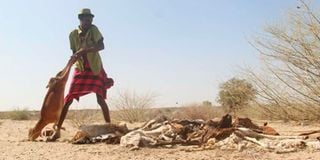Drought: NDMA partners with KDF to distribute livestock feeds

Government Spokesperson Col (Rtd) Cyrus Oguna distributes rice to a resident of Lungalunga in Kwale County. The government will spend Sh680 million in a cash transfer programme to supplement relief food distribution in areas affected by drought.
The National Drought Management Authority (NDMA) has partnered with the Kenya Defence Forces (KDF) to distribute livestock feeds in counties within arid and semi-arid lands (Asal) in order to cushion vulnerable communities. This comes amid shortages of feeds and water brought about by the current dry spell.
Seven counties have been classified in the drought alarm phase –Turkana, Marsabit, Wajir, Isiolo, Samburu, Baringo and Mandera.
Another 10 – West Pokot, Garissa, Kilifi, Kwale, Lamu, Laikipia, Meru North, Nyeri, Tharaka Nithi and Kitui – have been placed on alert.
Through the collaboration, the military will help distribute an initial consignment of 2,700 bags of livestock feeds of 50kg each in Marsabit County.
Since last October, NDMA has distributed 101,200 such bags to Asal counties with support from the European Union. In the same period, the agency has supported other drought response interventions in 17 Asal counties to the tune of Sh405 million.
Logistical support
NDMA’s Chief Executive Hared Adan said the agency is leveraging KDF’s logistical support to accelerate the transportation and distribution of feeds in far-flung areas in the worst-hit areas.
“The coming on board of KDF to support transportation of feeds will reduce logistical challenges. We thank the military for the continued support and look forward to similar support in Baringo County,” he said.
Under the arrangement, KDF will support NDMA to transport more feeds to Baringo County targeting Tiaty East, Tiaty West and Mogotio sub-counties.

A herder dumps a dead goat onto a pile of carcasses in Illeret, Marsabit County. The devastating drought in Northern Kenya has left pastoralist communities without pasture leading to death of hundreds of thousands of livestock.
In Marsabit, livestock feeds will be distributed in Moyale and Saku sub-counties, while the county expects another 3,575 bags from the Food and Agriculture Organisation that will be distributed in North Horr and Laisamis sub-counties. The feed supplements are expected to avert livestock deaths in the most affected areas.
Mr Adan attributed the ongoing drought to the poor performance of the 2021 short rains and previous failed rainfall seasons. The drought has left 3.1 million people in 23 Asal counties in need of relief assistance, a figure projected to rise to 3.5 million by June.
“Besides interventions aimed at building long-term resilience, NDMA is also supporting water trucking, repairing and providing fuel subsidies to strategic boreholes, as well as providing water storage tanks to schools and health institutions in several Asal counties,” he said.
He urged more stakeholders to support the drought response interventions as the long rains are expected to be inadequate, a situation that will lead to food shortages in Asal counties.
Mr Adan called on stakeholders to work within the established drought coordination structures, such as the County Steering Groups, to reach out to affected areas.

A man walks past a carcass of a sheep at Maikona in Marsabit County in April 2019.
The agency said the drought had weakened animals, resulting in low milk production and market prices.
“The government has put in place drought mitigation measures to cushion communities such as emergency relief and regular cash. A 50kg bag of the specially formulated and highly nutritious supplements, dubbed Drought Pellets, feeds a cow for 25 days and a sheep/goat for 100 days,” the agency said.
“The feeds target livestock left behind as the larger herds migrate in search of pasture and water. These herds provide milk for family members who remain at home, especially children, women and the elderly.”





